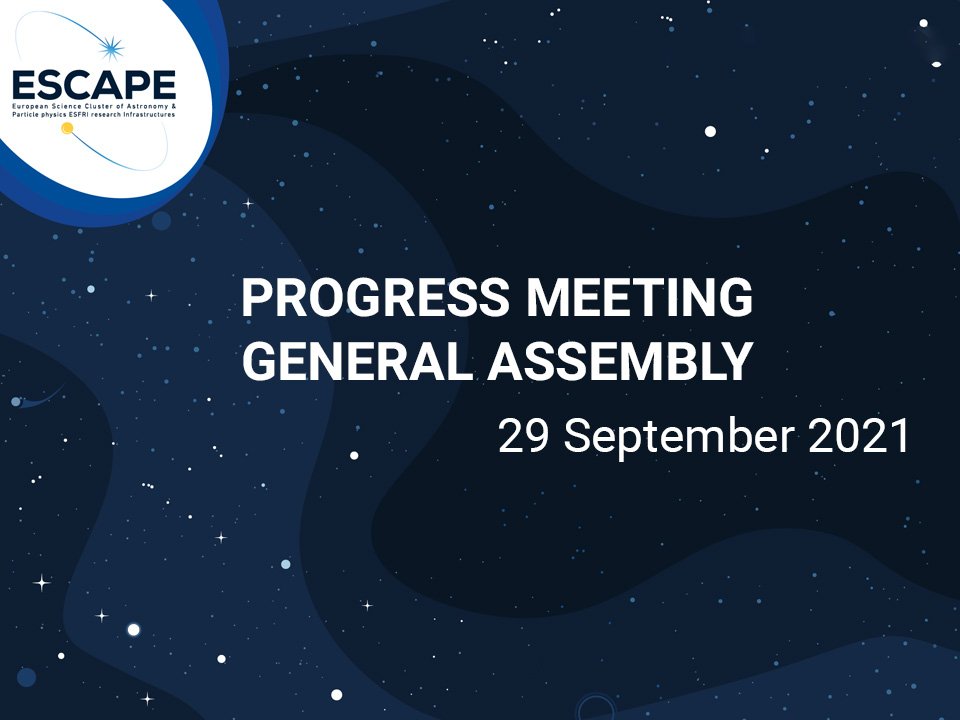

ESCAPE, one of EOSC's scientific clusters
"ESCAPE is one of five research Infrastructure Science Clusters proposed in 2018 in response to a dedicated H2020 call," explained Giovanni Lamanna, ESCAPE coordinator. "The five Science Clusters connect ESFRI research infrastructures with the European open science cloud (EOSC) and aim to facilitate researchers' access to scientific data and results, accelerate discoveries, and increase scientific value through data sharing and more."
From open science to open data
The ESCAPE project brings together the astronomy, astroparticle and particle physics communities to address open science challenges in data-driven research, inspired by the goals and needs of major European research infrastructures, or ESFRIs. The large professional community engaged in science linked to ESCAPE counts tens of thousands of scientists. ESCAPE aims to produce versatile solutions to support the implementation of the European Open Science Cloud by fostering a multi-disciplinary environment, including open data management according to FAIR principles.
“Our goal is to enable interoperability between facilities, encourage cross-fertilization, and develop joint multiwavelength and multimessenger data processing and analysis capabilities”, said Giovanni Lamanna.
ESCAPE services
In support of this goal, ESCAPE is developing a range of services, including data infrastructure, a software repository, virtual observatory and citizen science.
A Data Lake for Open Science
"For the first time flagship ESFRIs are collaborating together since the real beginning to implement the standards of data FAIRness and Open Access in a common scientific data management infrastructure", says Xavier Espinal, WP2 leader, enthusiastically.
The "Data Lake for Open Science (DIOS)" aims to provide a common storage infrastructure with global data management orchestration capabilities (storage rules, policies and quality of service). It should enable open science for multidisciplinary research infrastructures and, by applying the FAIR principles and promoting open data, meet the needs of large-scale Exabyte-scale science projects. DIOS will also address smaller data storage and management needs and improve the use and potential of content delivery networks.
"The main Data Lake building blocks are deployed and operated by the ESCAPE partner institutes", adds Xavier. "The pilot is functional with 10 storage endpoints and the high level layer consolidated".
A full dress rehearsal exercise of the ESCAPE pilot Data Lake happened with success in late 2020 with a strong involvement from the Research Infrastructures and experiments. Another full-scale exercise, the Data and Analysis Challenge 20, will happen next month to review ESCAPE DIOS prototype performance. Eventually, ESCAPE will launch its data lake by June 2022 and will consider its deployment towards full production services within the EOSC.
Open-source Scientific Software and Service Repository
"We aim to share open science software and services based on FAIR principles", explains Kay Graf, WP3 leader,"in order to facilitate and support continuous development, deployment, exposure and preservation of partners ‘software/tools/services; foster an open innovation environment for open standards (e.g. workflows, data-formats) common regulations and shared software for multimessenges and multiprobe data".
All these objectives follow a pradigm of enabling open science, an community-based, inclusive approach, the FAIR principles and a federation of available resources.
« "How to onboard your project right now to the OSSR", asks Kay, "follow the steps from our current landing page"
At this stage of the project, the first version of OSSR has been implemented; the guidelines and best practices collected and the onboarding of partner software & services as well as other communities is on track.
See the video describing two use cases.
Connecting ESFRI to EOSC using the Virtual Observatory framework
“To make astronomy data and services FAIR to support open science, we need to evaluate and implement the connection of ESFRI and other astronomy research infrastructures to the EOSC through the Virtual Observatory", describes Mark Allen, WP3 leader, "we need to define and further implement the FAIR principles for astronomy data through common interoperability standards - extending the Virtual Observatory to new communities, but also establish data stewardship practices to add value to the scientific content of the ESFRI data archive”.
See the demo on video.
ESFRI Science Analysis Platform
This platform aims to help users engage with ESCAPE and other services by providing: data discovery and retrieval from a range of archives and data repositories; exploration and discovery of relevant tools in the ESCAPE software repository; access to a range of compute and analysis services provided by project partners and other facilities; orchestration of data, services, and software to help users create and access research environments that meet their needs.
“ESAP is not a single instance of a science platform", states John Swinbank WP5 leader,"but rather a “toolkit” that research infrastructures, institutions, projects, and others can use to create and manage analysis environments tailored to their particular needs. It provides a focal point for integrating diverse services, which are drawn from other providers“.
The existing prototype already provides a variety of powerful functionality , and more is being added all the time.
Here you can try the test system (please note this is an experimental system provided on a best-efforts basis).
Citizen Science
This service is all about connecting the ESCAPE science community to society at large, and vice versa.
“We want to improve access to data and tools through citizen science crowdsourcing experiments for most of the facilities in the ESCAPE remit", explains Stephen Serjeant WP6 leader, "and now that ESCAPE is contributing to the EOSC Future project to prototype a working European Open Science Cloud, our vision is very much to extend the remit of these two way-activities to the wider EOSC-Future science areas and facilities“.
One of a particular citizen science experiment that we have created as part of ESCAPE is called galaxy zoo clump scout:
“The objective is to find clumps in galaxies where stars are being born. And I'd like to draw your attention to the number of volunteers- nearly 14 thousand volunteers. But the science team is just three academics. It makes you realise how large the cohort of people are who really genuinely want to contribute to science!”.
Try the citizen science experiment.
ESCAPE and EOSC Future
“As ESCAPE technical coordinator", says Ian Bird, "I ensure that we are all aligned on the technical implementations in ESCAPE but also within EOSC Future, a prototype of an integrated EOSC. And the two Test Science Projects, on Dark Matter and the Extreme Universes, which should enhance researchers’ participation to EOSC, also fall within this scope”.
Results
Now at the halfway point, ESCAPE has led the way in demonstrating the open scientific capabilities of its services, putting high-level multidisciplinary scientific research into practice through the EOSC Future science projects that will change the way science and research is done.

A long-term vision
"Developing such a range of services also demonstrates the benefits of close collaboration", points out Giovanni Lammana. " These are all significant results and, in some cases, also structured operational lines for a long-term sustainable infrastructure for all our research projects".
Moreover, ESCAPE intends to remain a collaboration of ESFRI projetcs also after the end of the current H2020 project and in support of a number of collaborative actions: e.g. data management at Exascale, common software challenges and cross-fertilisation of software tools and services, building a platform for multi-messenger astronomy and cross-domain science collaborations, and developing operational connections of data infrastructures with heterogeneous computing infrastructures.
Learn more and see the full presentations.
Views
39,342

